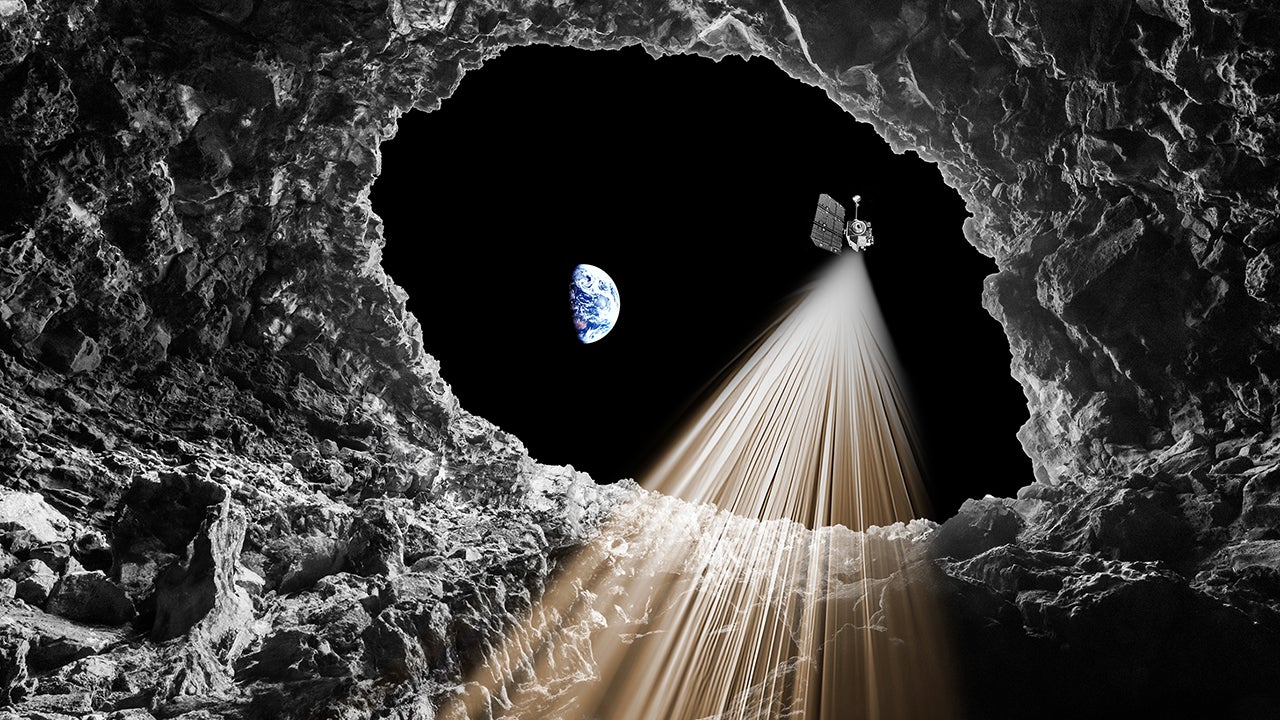For the first time, an international team of scientists have confirmed the existence of a large underground tunnel beneath the Moon’s surface, which could one day be used by future astronauts sheltering from the temperature and radiation extremes that scour the lunar landscape.
Since 2009, over 200 shadow-drenched openings have been discovered marking the lunar surface. It has been suspected for decades that a number of these openings may have been formed as a result of volcanic activity, and that they may even host subsurface openings sculpted by flowing lava in the distant past. Now, a new Nature Astronomy study has revealed exactly what lies beyond the entrance of one of one such pit, located in the Mare Tranquillitatis region of the lunar surface.
The data at the heart of the paper was captured by NASA’s Lunar Reconnaissance Orbiter’s Miniature Radio-Frequency (Mini-RF) instrument back in 2010, as it passed tens of kilometres above Earth’s largest natural satellite. The Mini-RF instrument is a type of synthetic aperture radar, which works by firing electromagnetic waves at the lunar surface, and listening out for the radar ‘echoes’ that bounce back towards the spacecraft.
Using cutting edge signal processing techniques, the researchers — led by scientists from the University of Trento in Italy — were able to decipher the LRO data to determine the nature of the cavern beneath the shadowed Mare Tranquillitatis opening.
"Thanks to the analysis of the data we were able to create a model of a portion of the conduit," said Leonardo Carrer, an assistant professor at University of Trento who co-authored the new paper. "The most likely explanation for our observations is an empty lava tube."
Whilst scientists have suspected for decades that lunar pits may play host to extended cave systems carved out by lava in the distant past, the new Nature Astronomy study represents the first time that radar data has been used to demonstrate the existence of such a tunnel.
The data revealed a subsurface cave that extends for tens of meters, which suggests that a more expansive hidden area may exist beyond. The authors of the research believe that the Mare Tranquillitatis cave, and others like it, could serve as promising locations for future lunar habitats, which would make use of the lunar soil — or regolith — above as natural protection from solar radiation, and extreme surface temperatures.
There is an accessible cave conduit under the lunar surface. Carrer et al.: https://t.co/HnW6g5AjDs pic.twitter.com/bOAi9htsGg
— Nature Astronomy (@NatureAstronomy) July 15, 2024
According to NASA, temperatures on the sunlit side of the Moon can rise to 260 °F (127 °C), while the shadowed side is cooled to -280°F (-173°C). However, the temperature in the lunar pits is estimated to be a more comfortable 63 °F (17 °C), and is thought to fluctuate relatively little.
Setting up camp below ground would also provide a natural defence against the ever present threat of micrometeorite impacts, and would also shelter astronauts from radiation emanating from our Sun, and further afield, which is around 150 more potent than the dosage we receive on Earth.
Of course attempting to make a home in a lunar pit would create countless issues of its own, that must be countered with the invention of bold new technologies. NASA’s next crewed exploration mission is set to take place in September 2025, and will see astronauts launch aboard the agency’s Orion spacecraft to orbit the Moon, before returning to Earth’s atmospheric embrace. However, it won’t be until September 2026 at the earliest that the planned Artemis III mission makes history by returning U.S. astronauts to the lunar surface, where the agency hopes to establish a permanent presence, before forging a path on to Mars.
Image credit: Credits: Elaboration of a photo of A. Romeo. LRO 3D model by NASA (Brian Kumanchik, Christian Lopez. NASA/JPL-Caltech), Earthrise photo captured on Taken on 24 December 1968, 16:40 UTC by Apollo 8 astronaut Bill Anders.
Anthony is a freelance contributor covering science and video gaming news for IGN. He has over eight years experience of covering breaking developments in multiple scientific fields and absolutely no time for your shenanigans. Follow him on Twitter @BeardConGamer









